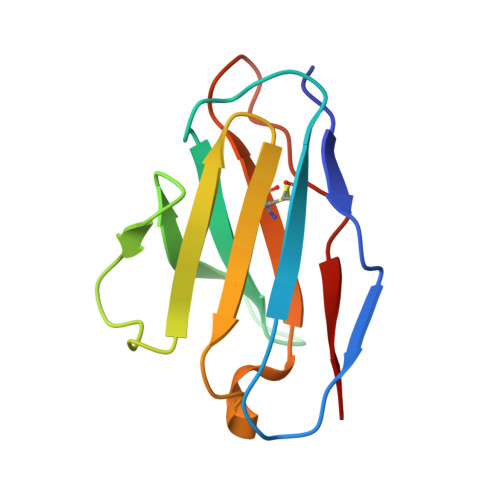Structural basis of broad SARS-CoV-2 cross-neutralization by affinity-matured public antibodies.
Sheward, D.J., Pushparaj, P., Das, H., Greaney, A.J., Kim, C., Kim, S., Hanke, L., Hyllner, E., Dyrdak, R., Lee, J., Dopico, X.C., Dosenovic, P., Peacock, T.P., McInerney, G.M., Albert, J., Corcoran, M., Bloom, J.D., Murrell, B., Karlsson Hedestam, G.B., Hallberg, B.M.(2024) Cell Rep Med 5: 101577-101577
- PubMed: 38761799
- DOI: https://doi.org/10.1016/j.xcrm.2024.101577
- Primary Citation of Related Structures:
8C0Y, 8C2R, 8V4F - PubMed Abstract:
Descendants of the severe acute respiratory syndrome coronavirus 2 (SARS-CoV-2) Omicron variant now account for almost all SARS-CoV-2 infections. The Omicron variant and its sublineages have spike glycoproteins that are highly diverged from the pandemic founder and first-generation vaccine strain, resulting in significant evasion from monoclonal antibody therapeutics and vaccines. Understanding how commonly elicited antibodies can broaden to cross-neutralize escape variants is crucial. We isolate IGHV3-53, using "public" monoclonal antibodies (mAbs) from an individual 7 months post infection with the ancestral virus and identify antibodies that exhibit potent and broad cross-neutralization, extending to the BA.1, BA.2, and BA.4/BA.5 sublineages of Omicron. Deep mutational scanning reveals these mAbs' high resistance to viral escape. Structural analysis via cryoelectron microscopy of a representative broadly neutralizing antibody, CAB-A17, in complex with the Omicron BA.1 spike highlights the structural underpinnings of this broad neutralization. By reintroducing somatic hypermutations into a germline-reverted CAB-A17, we delineate the role of affinity maturation in the development of cross-neutralization by a public class of antibodies.
- Department of Microbiology, Tumor and Cell Biology, Karolinska Institutet, Stockholm, Sweden; Division of Medical Virology, Institute of Infectious Diseases and Molecular Medicine, University of Cape Town, Cape Town, South Africa.
Organizational Affiliation:


















